7 Causes of Uneven Brake Pad Wear (Why is One Side Thicker?)
Brake pads create necessary friction by pressing against spinning rotors when you brake. Normally, you’d want to see even wear on both sides no matter what type of brake pad you use.
However, there are situations where the brake pads may wear unevenly on each side and you will be forced to replace all of the brake pads sooner than expected. To avoid that unnecessary expense in the future, it’s crucial you find the cause of uneven brake pad wear before it happens again.

Top 7 Reasons Your Brake Pads Wear Unevenly
Below are the most common reasons that brake pads wear out unevenly on each side of the vehicle.
Related: 7 Reasons Your Car Pulls to the Right or Left When Braking
#1 – Rotor Thickness Variation
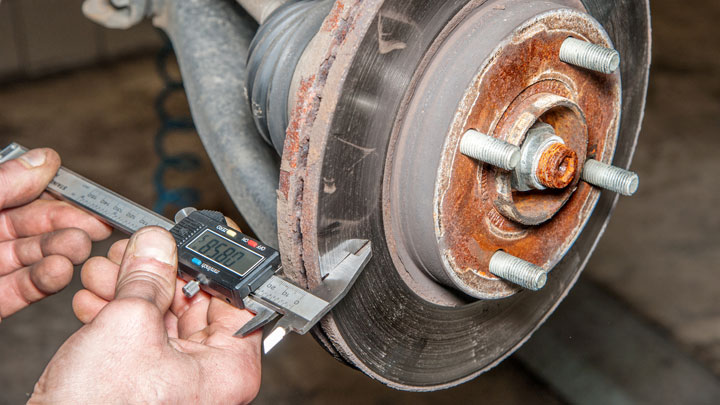
Disc thickness variation is a mechanical term which refers to when the rotors of a vehicle have different levels of thickness. Whenever there is a variation in the thickness level of your rotors, it will cause the brake pads to get worn out faster.
The rotors will have more flat spots that the brake pads will come in contact with. Once they do, the wear of the brake pads will become uneven on that corner of the vehicle.
#2 – Sticky Caliper Pistons

If you some debris or rust on one or more of your pistons, then it can cause sticky brake calipers. This means that the piston won’t slide correctly, causing the brake pad to make constant contact with its corresponding rotor.
A stuck brake caliper will cause the brake pad material to be used up much quicker than the others.
#3 – Misalignment
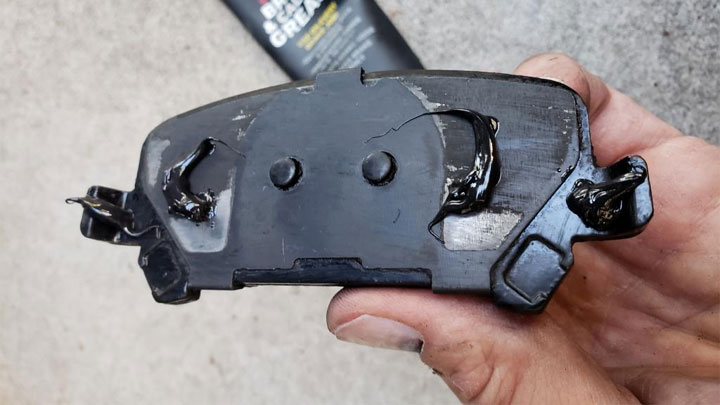
Sometimes when you have new brake pads installed in your vehicle, the mechanic might not align them evenly, sometimes due to a bent bracket on the back of the pad. Anytime you have misaligned brake pads, it will cause them to wear unevenly throughout the course of your braking activities.
You should notice this problem occurring within a few days of getting new brake pads that are misaligned. Once you start experiencing braking issues, you will wonder why your brake pads are acting up already when you just got them replaced.
Well, it is due to the brake pads wearing out unevenly because they are not aligned correctly in the caliper.
#4 – Dirty or Rusty Rotors

Dirty rotors are certainly one possible cause of uneven wear and tear of your brake pads. These do not need to be old rotors either.
Sometimes when new rotors are installed in a vehicle, they might still have dirt or grease on them from the install procedure. The rotors need to be cleaned with a formulated brake cleaner to ensure this debris is removed from them.
When you buy new rotors, they often come with a gray paint-like coating for the purpose of rust protection. While it’s ok to use brake cleaner to take remove it, it’s not necessary. Normal brake operation will remove that coating as the pads contact the rotor.
#5 – Warped Rotors
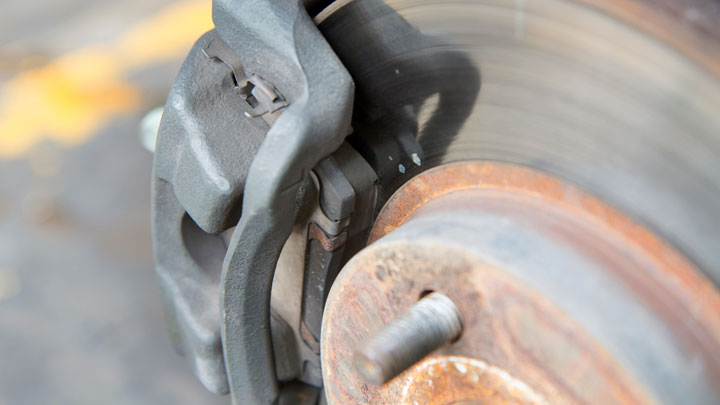
A warped rotor means that the surface of it is not perfectly smooth, but slightly deformed or wavy. This usually happens when cold water makes contact with a scorching hot rotor.
When you have a warped rotor, the brake pad only makes contact with the high points of the rotor while the other pads make full contact. This results in uneven pad wear.
This is why you should never immediately spray water on your wheels and start washing your car immediately after some spirited driving. You want to make sure the rotors have been given enough time to cool down so they are simply warm to the touch and not hot.
To confirm, simply place your hand a few inches from the rotor. If you feel a lot of heat, wait a few minutes before using water.
#6 – Corroded or Seized Guide Pins
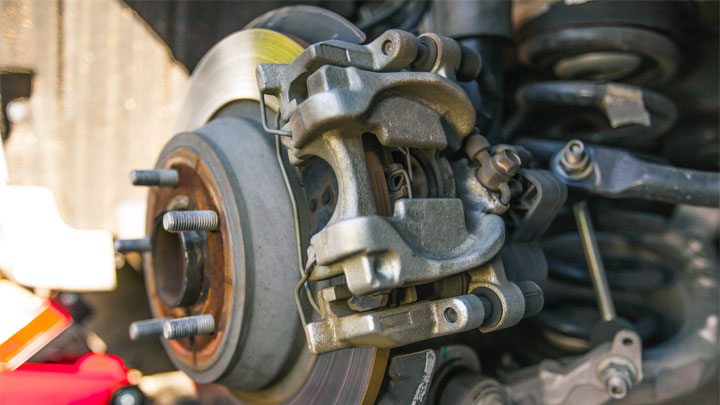
Another common culprit is corroded or seized guide pins. These pins help your caliper slide and compress the brake pads against the rotors. When debris or moisture builds up, corrosion can occur. This may restrict caliper movement, leading to uneven wear on your brake pads.
To avoid this issue, you should clean and lubricate the caliper guide pins regularly. Doing so will help prevent rust, reduce friction, and keep your brake pads in good condition.
#7 – Different Types of Brake Pads

It is important that you stay consistent with the type of brake pads that you install in your braking system. Do not use different brands or materials of brake pads because they are likely going to wear down at different rates and have a completely different lifespan.
If you stay with the same model and thickness in your brake pads, then you will have a better chance of them wearing evenly.
Preventing Uneven Brake Pad Wear
Regular Brake Inspections
To maintain your brake system’s performance and avoid uneven brake pad wear, scheduling regular brake service appointments with a trusted mechanic is one of the best things you can do. Regular inspections of brake pads, lines, calipers, and other components help catch any issues early on, keeping the stopping power of your front and rear brakes balanced.
Proper Brake Pad Installation
During a brake pad replacement, it’s critical that the technician properly installs and aligns the new brake pads. Misalignment or bent brackets can cause uneven wear, reducing the effectiveness of your brake system.
If you want to try changing your own brake pads, make sure you follow the correct procedure and take your time.
Maintain Brake Components
Maintaining the various components of your brake system, like cleaning and lubricating slide pins or replacing worn-out caliper pin boots, helps prevent uneven brake pad wear. By investing time in regular maintenance, you can extend the life of your brake pads as well as other brake components.
Diagnosing Uneven Brake Pad Wear
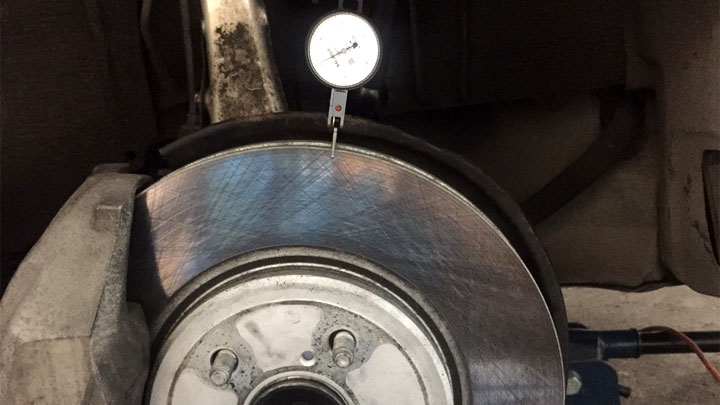
Identify Brake Pad Wear Patterns
To diagnose uneven brake pad wear, inspect the pads for a wedge or taper. This can indicate quality or installation issues. Check the difference between wear on the inner and outer pads. Outer pads wearing more than inner pads may indicate guide pin problems.
Assess Rotor Thickness Variation
Inspect for rotor (disc) thickness variation (DTV) after checking brake pad wear patterns. DTV is differences in rotor thickness at various contact points from uneven wear. Excessive DTV can cause brake judder or pulsation.
Measure rotor thickness with a micrometer at multiple points around the circumference to ensure they’re within the allowable limit. If you don’t have the ability to do this yourself, any brake shop will be able to do this.
Check for Residual Brake Pressure
Check for residual brake fluid pressure to prevent pistons from sticking and causing uneven wear on brake pads. Bleed your brakes and inspect the system for signs of residual pressure to identify potential issues and maintain optimal brake performance.
Fixing Uneven Brake Pad Wear
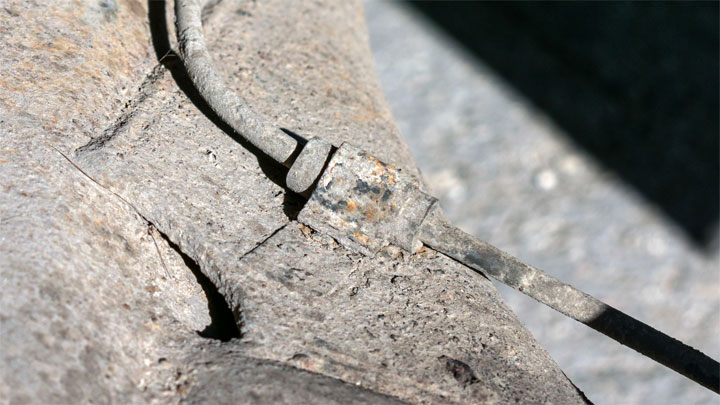
Sometimes your brakes need a little TLC to fix brake pads that are wearing unevenly. Without determining the root cause, simply replacing brake pads will often result in the new pads wearing unevenly as well. Here’s what to do instead:
- First, inspect the brake caliper and its components. Check if the caliper piston is functioning correctly and not seized. If there’s an issue, you may need to replace the brake caliper or piston.
- In addition, pay attention to the guide pins, as they play an important role in preventing uneven brake pad wear. Properly lubricating the slide pins ensures that your floating caliper moves freely. If you spot corroded or damaged slide pins, be sure to replace them.
- Examine the brake lines for any signs of wear or damage. If there’s excessive heat or obvious damage, it’s time to replace your brake line.
- Next, take a look at the rotor thickness to ensure it’s within the acceptable range. You can find disc thickness values in your vehicle’s repair manual or consult a professional mechanic. If the rotor is too thin, you’ll need to get it (and the opposite rotor) replaced.
- While working on these components, don’t forget to address the brake pads themselves. For best results, choose high-quality brake pads that match your vehicle’s specifications.
FAQs
Why Are My Brake Pads Wearing Diagonally?
Some common causes of your brake pads wearing diagonally include rotor damage that puts uneven pressure on the pads, seized guide pins that do not allow the pads to retract, a brake line that won’t allow fluid to flow back and forth, issues with the master cylinder pumping fluid, and a leaking or sticking caliper.
Is It Dangerous to Drive With Uneven Brake Pad Wear?
Yes, driving with uneven brake pad wear can be dangerous, as it may compromise your vehicle’s braking performance. Uneven pad wear can lead to longer stopping distances, increased brake pedal effort, or reduced brake responsiveness.
These issues might cause a loss of control or increase the risk of vehicle accidents.
What Are the Signs of Uneven Rotor Wear?
Uneven rotor wear may manifest through various signs, including a pulsating or vibrating brake pedal, steering wheel vibration while braking, and inconsistent braking performance. Additionally, you might hear a grinding or scraping noise when applying the brakes.
- Replace the Engine or Replace the Car? (11 Factors to Consider) - Apr 11, 2024
- Plastic Piece Dragging Under Your Car? (What It Is and What To Do) - Mar 21, 2024
- Timing Belt vs Timing Chain (What’s the Difference?) - Feb 27, 2024

I just changed my rear brakes and rotors on my ford transit 250. Passenger side was metal to metal. driver side was only 75 % worn. Any thoughts?
I don’t know. Maybe there was some air in the lines on one side.
Hi I have just replaced brake pads. Just took off to check and I have the ends of the pads worn down .How is this possible?
To clarify, are you saying the edges of the pads are worn more than the centers?
Just pulled my brakes off and one pad is almost new the other is worn right down. They are new calipers that came with brake pads already. The one that looks like it has lots of life feels really tight, I can barely move it. It should really move freely.
I guess when you buy them new you should always check to see if there in snug or just jammed in there which appears that’s what they are. So I’m going to replace them with new pads I’ll have a spare one for some other time but I’ll have to file it down so it will sit in snug and almost free.
One pad is worn substantially more than the other on the same caliper?
1. Correct
2. Can be bad pistons, but more often than not, it’s sticking caliper pins, which can be easily corrected. Use something me valve lapping compound and an impact gun in the pin hole, spin at high speed for 30 seconds, CLEAN THOROUGHLY, and grease well with pad/slide grease, not anti-seize, which is sticky…
3. How do you “misalign” pads? They only go in one way, even if they’re not pushed in all the way, the caliper will push them flush, unless they’re not in correctly at all.
4. Brake rotors don’t need to be cleaned with a specialized formula. We all use brake parts cleaner, but your ASE certification should teach you that the proper way to clean off the shipping anti rust oil on rotors is with soap and warm water, not with Brake Clean…
Also, where would you apply an anti-rust coating? The surface that makes contact with the pads has constant friction on it, it would wear off any coating, plus a coating would prevent the pads from making proper contact with the rotor, harming braking performance. Any rust on the perimeter won’t make any difference to brake performance…
5. The water part of this is accurate enough for the average reader…
Warped rotors can definitely effect pad wear, you’ll usually notice it when braking from speed, a pulsation in brake pedal and/or steering wheel specifically when braking…
6. 100%, do not mix pad material/manufacturer per axle (different on front and rear is ok, but will wear at different rates in respect to each other)
7. Corrosion buildup on brake hanger (where pads slide), causing binding and preventing movement
8. Wearing/degrading brake hoses, allowing pressure to enter and not leave the caliper, though this is usually more notable when brakes are wearing excessively on one side.
Hey Ben, thanks for the comment. To clarify #3, brake pads are supposed to be only installable in one direction. However, if the installer is not paying attention, they could install the pads with the backing plate facing the rotor (in other words, on the wrong side of the caliper). Obviously the installer *should* notice this error very quickly when they go for a test drive.
Thanks for #7 and #8. Those are good tips to include.
I renewed the front brake discs and pads on my BMW X3 I now find after a few months that only half the pads seem to be in contact with the discs, that is the top half of the discs the bottom halves are quite rusty, why would this happen, my car is only three years old and done 22000 miles
I’m not sure. If it were my car I’d pull the brakes on that side and inspect them. I would be curious to know if the wear on the inside pad looks like what you’re seeing on the outside, or perhaps the opposite wear pattern.
Replaced 2 rear calipers and pads.right caliper has chomped thru 1 brake pad within a month. Any ideas
Sounds like that caliper may be sticking. It may be an issue with the brake line on that side, or that caliper may need a rebuild.
Typically instead of rebuilding the caliper yourself, people just swap calipers for another remanufactured one. You may be able to find an OEM replacement instead of a remanufactured caliper if you search for one online.
Pull the caliper off and inspect how tight the pads are held in place.
They should be able to move fairly freely, unless the shins are specially designed to hold them in place.
If they’re too tight, pull the shims off, and file beneath the shims to remove any corrosion that has built up.
Next, check the slide pins (if equipped) to make sure they move freely. Add brake pad lube as needed (not anti-seize!)
If all those are free from issue, I’d suspect the caliper if it has multiple pistons.
Your post doesn’t clarify well how the pad is wearing unevenly, top to bottom (outside of rotor to inside of rotor), or left to right (side to side of pad). But there are very few moving parts that go into brakes…
If you ever solved the concern, please let us know!!
amazing info thank you